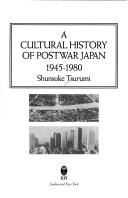| Listing 1 - 10 of 54 | << page >> |
Sort by
|
Dissertation
Abstract | Keywords | Export | Availability | Bookmark
 Loading...
Loading...Choose an application
- Reference Manager
- EndNote
- RefWorks (Direct export to RefWorks)
Book
ISBN: 9780691015774 9780691015781 0691015783 Year: 2009 Publisher: Princeton, NJ Princeton University press
Abstract | Keywords | Export | Availability | Bookmark
 Loading...
Loading...Choose an application
- Reference Manager
- EndNote
- RefWorks (Direct export to RefWorks)
#SBIB:39A75 --- #SBIB:39A4 --- #SBIB:95G --- Etnografie: Azië --- Toegepaste antropologie --- Geschiedenis van Azië (inclusief Arabische wereld, Nabije Oosten)
Book
ISBN: 0905838297 0900966920 9780900966927 9780905838298 Year: 1973 Publisher: London: Hurst,
Abstract | Keywords | Export | Availability | Bookmark
 Loading...
Loading...Choose an application
- Reference Manager
- EndNote
- RefWorks (Direct export to RefWorks)
Book
ISBN: 9780199390427 0199390428 9780199732159 0199732159 Year: 2011 Publisher: Oxford [etc.] Oxford University Press
Abstract | Keywords | Export | Availability | Bookmark
 Loading...
Loading...Choose an application
- Reference Manager
- EndNote
- RefWorks (Direct export to RefWorks)
This Handbook is a current, comprehensive single-volume history of Iranian civilization. The authors, all leaders in their fields, emphasize the large-scale continuities of Iranian history while also describing the important patterns of transformation that have characterized Iran's past. Each of the chapters focuses on a specific epoch of Iranian history and surveys the general political, social, cultural, and economic issues of that era. The ancient period begins with chapters considering the anthropological evidence of the prehistoric era, through to the early settled civilizations of the Iranian plateau, and continuing to the rise of the ancient Persian empires. The medieval section first considers the Arab-Muslim conquest of the seventh century, and then moves on to discuss the growing Turkish influence filtering in from Central Asia beginning in the tenth and eleventh centuries. The last third of the book covers Iran in the modern era by considering the rise of the Safavid state and its accompanying policy of centralization, the introduction of Shi'ism, the problems of reform and modernization in the Qajar and Pahlavi periods, and the revolution of 1978-79 and its aftermath. The book is a collaborative exercise among scholars specializing in a variety of sub-fields, and across a number of disciplines, including history, art history, classics, literature, politics, and linguistics. Here, readers can find a reliable and accessible narrative that can serve as an authoritative guide to the field of Iranian studies.
#SBIB:328H515 --- #SBIB:95G --- Instellingen en beleid: Iran --- Geschiedenis van Azië (inclusief Arabische wereld, Nabije Oosten) --- Iran --- History. --- Civilization.
Book
ISBN: 0471061174 0471061190 Year: 1976 Publisher: London Wiley
Abstract | Keywords | Export | Availability | Bookmark
 Loading...
Loading...Choose an application
- Reference Manager
- EndNote
- RefWorks (Direct export to RefWorks)
Book
ISBN: 0801822041 Year: 1981 Publisher: Baltimore Johns Hopkins university press
Abstract | Keywords | Export | Availability | Bookmark
 Loading...
Loading...Choose an application
- Reference Manager
- EndNote
- RefWorks (Direct export to RefWorks)
Book
ISBN: 0049500163 0049500155 Year: 1973 Publisher: London
Abstract | Keywords | Export | Availability | Bookmark
 Loading...
Loading...Choose an application
- Reference Manager
- EndNote
- RefWorks (Direct export to RefWorks)
#SBIB:95G --- Geschiedenis van Azië (inclusief Arabische wereld, Nabije Oosten) --- History of Asia --- Far East --- East Asia --- Extrême-Orient --- History --- Histoire --- History.

ISBN: 0226345211 Year: 1969 Publisher: Chicago (Ill.) University of Chicago press
Abstract | Keywords | Export | Availability | Bookmark
 Loading...
Loading...Choose an application
- Reference Manager
- EndNote
- RefWorks (Direct export to RefWorks)

ISBN: 0710302592 Year: 1987 Publisher: London KPI
Abstract | Keywords | Export | Availability | Bookmark
 Loading...
Loading...Choose an application
- Reference Manager
- EndNote
- RefWorks (Direct export to RefWorks)
#SBIB:39A75 --- #SBIB:95G --- Popular culture --- Etnografie: Azië --- Geschiedenis van Azië (inclusief Arabische wereld, Nabije Oosten) --- Japan --- Social life and customs --- -Popular culture.
Book
Abstract | Keywords | Export | Availability | Bookmark
 Loading...
Loading...Choose an application
- Reference Manager
- EndNote
- RefWorks (Direct export to RefWorks)
Between July 1920 and February 1921, in the territory known as Mesopotamia--now the modern state of Iraq--an Arab uprising came perilously close to inflicting a shattering defeat upon the British Empire. A huge peasant army led by Shi'i clerics, Baghdad notables, disaffected sheikhs and former Ottoman army officers surrounded and besieged British garrisons with sandbagged entrenchments; British columns and armoured trains were ambushed and destroyed; and well-armed British gunboats were sunk or captured. The quest for oil was central to Britain's Middle East policy during the First World War and was one of the principal reasons for its continuing occupation of Iraq. However, with around 131,000 Arabs in arms at one stage of the conflict, the British were very nearly driven out. Only a massive infusion of Indian troops and the widespread use of aircraft prevented a total rout. This book is the history of the first British occupation of Iraq and the revolt against it in 1920--the most serious armed uprising against British rule int eh twentieth century. Using a wealth of primary sources, author Ian Rutledge brings central players such as Winston Churchill, Arnold Wilson, T.E. Lawrence, Gertrude Bell and Sit Mark Sykes vividly to life in this gripping account.
World War, 1914-1918 --- #SBIB:95G --- Campaigns --- Geschiedenis van Azië (inclusief Arabische wereld, Nabije Oosten) --- Revolt (Iraq : 1920) --- World War (1914-1918) --- Iraq --- History
| Listing 1 - 10 of 54 | << page >> |
Sort by
|

 Search
Search Feedback
Feedback About UniCat
About UniCat  Help
Help News
News